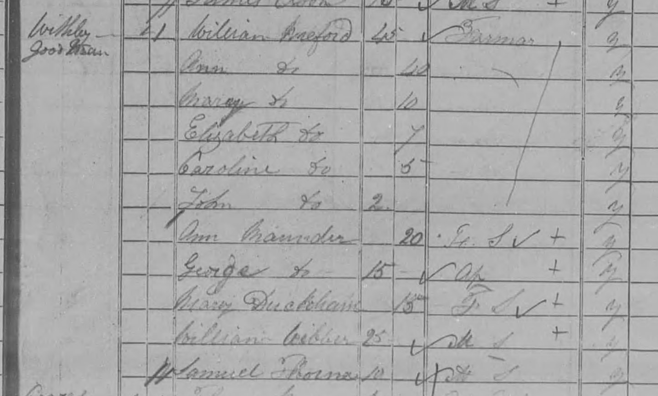In the 1841 census, William Wreford was recorded at ‘Withley Goodman‘, near Tiverton, with his second wife Ann, and their four children. He was recorded simply as ‘Farmer’.

I’d already found the location of the farm, but now, using the 1841 tithe maps and apportionments on the Devon County Council website, I’ve been able to establish the exact land that William farmed!
Tithes were a kind of tax where one tenth of all agricultural produce was paid annually to support the local church and clergy. The Tithe Commutation Act was passed in 1836 to convert this to monetary payments. A tithe survey was carried out in each parish to value the land, discover what tithes were payable and calculate each landowner’s liability.
In the survey conducted in 1841, William was recorded as the occupier of Withleigh Goodman in the Priors district of the parish of Tiverton. At this time, the farm consisted of 21 plots, which came to a total of 54 acres, 3 roods, and 12 perches. This works out to 221, 879 square metres (about 22 hectares).

William did not own the land he farmed. In 1841, the landowner of Withleigh Goodman was Richard Morrish ‘as Trustee for George Brook Maunder’.
These tithe records have triggered a new set of questions.
- What was the Maunder link?
- Who was George Brook Maunder? And why did he need a trustee?
- Who was Robert Morrish?
What was the Maunder link?
Maunder was the previous surname of William’s wife, Ann. It was also the surname of two other inhabitants of the house, Ann Maunder (20, female servant) and George Maunder (15, apprentice).
I’d long thought of Maunder as being Ann’s maiden name but it’s possible that Maunder was a married name, and the young Maunders are actually Ann’s children. William and Ann’s marital status was not noted on their marriage record, but I know William was widowed so Ann could have been too. 1841 census ages are ‘iffy’, but other records show Ann was actually about 45 years old – old enough to be the mother of children aged 20 and 15.
Who was George Brook Maunder?
The only records for George Brook Maunder that I could find, suggest he was baptised in 1825 at Puddington (about 5 miles from Withleigh). He was the son of a George and Ann, who resided at Coombe.

This couple also had a daughter named Ann, baptised in 1820.

This ties in with the ages of the George and Ann Maunder at Withleigh Goodman in 1841.
Why would George Brook Maunder need a trustee?
George Maunder, a yeoman of Coombe, died in 1826. It appears that he bequeathed the land to his eldest (and only living) son, George Brook Maunder. A trustee would have been appointed since his son was not of age. The will should be consulted to prove this theory.
Although not proven, it’s looking a lot like William’s wife, Ann, was the widow of George Maunder. This would mean that the Maunders recorded on the 1841 census were her children from this previous marriage, and her son George was the legal owner of the property that William Wreford was farming.
Next Steps:
- obtain a copy of George Maunder’s 1826 will
